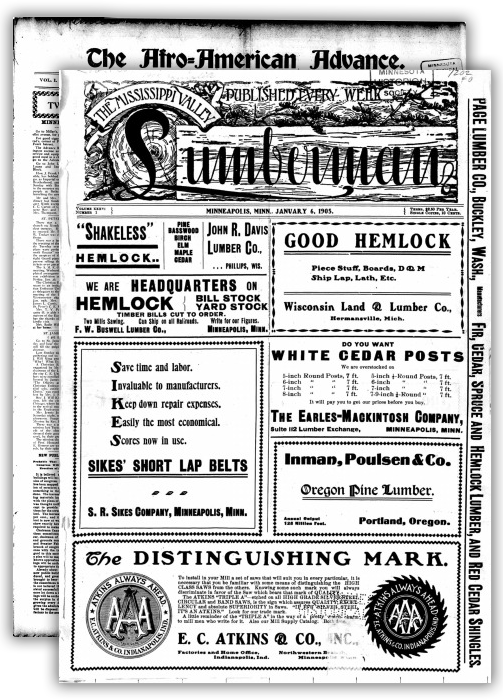
hub
Introduction
titles
About the titles
corporations foundations
Search the Newspapers
hub-faq
F.A.Q.
Choose a Menu
-
hubIntroduction
-
titlesAbout the titles
-
corporations foundationsSearch the Newspapers
-
hub-faqF.A.Q.
Truth
Labor leader (Duluth, Minn.) 1917 Browse the title
Truth (Duluth, Minn.) 1917-1923 Browse the title
Irish felon (Duluth, Minn.) 1919 Browse the title
The Duluth Labor Leader, a weekly publication of the Scandinavian local of the Socialist Party in Duluth, published its first issue on May 1, 1917, under editor W.E. Reynolds. The local founded its own newspaper due to its disappointment with another Duluth-area labor publication, the Duluth Labor World, which they felt had not effectively responded to the April 1917 strike of the Duluth Local 165 of the Boilermakers, Shipbuilders, and Helpers Union.
From the beginning of its run, the Labor Leader voiced opposition to the United States’ involvement in World War I, which the country had entered in April 1917. The paper fought against wartime government actions which it viewed as oppressive, including censorship, the Espionage Bill, and proposed conscription, calling these an "effort to Prussianize America." The Labor Leader also voiced support for the Industrial Workers of the World (IWW), an international labor union with ties to both socialist and anarchist labor movements, and criticised the Minnesota Public Safety Commission (MPSC) for their repression of the IWW. In June of 1917 a detective employed by the MPCS began following the paper’s editor.
In September 1917, the U.S. Postmaster revoked Labor Leader’s second-class mailing permit normally used by newspapers, a method used during the war to censor "disloyal" media. In response, the newspaper was reborn on October 12, 1917 as Truth, retaining the same message, scope and editor as Labor Leader. Truth was vocal in its support of the Communist revolution taking place in Russia at the time, and in the fall of 1917 began printing pronouncements written by Vladimir Lenin and Leon Trotsky. On April 20, 1919, Truth issued a single-issue supplement titled Irish Felon to commemorate the third anniversary of the 1916 Irish rebellion.
When the American Socialist Party split into distinct Socialist and Communist factions in 1919, the Duluth Scandinavian Socialists voted to join the Communists. On November 7, 1919, the masthead of Truth featured the emblem of the Communist Labor Party of America for the first time. One week later Truth’s editor, Jack Carney, was arrested as part of a federal crackdown on suspected “alien radicals.” Carney was convicted of espionage in March 1920 for having written an editorial titled "Hands off Soviet Russia", but was released from prison later that year and took up editorship of a radical socialist newspaper in Butte, Montana, the Daily Bulletin.
Though remaining committed to Communism in its pages, Truth attempted to distance itself from the Party to avoid further attacks. By January 9, 1920, the hammer and sickle had vanished from the masthead of Truth, and a notice was printed stating that it was now "deemed advisable to disband the Communist Labor Party of Minnesota." Truth continued to publish its views in support of the working people of Duluth, under new editor J.O. Bentall. The paper published its last issue on April 13, 1923, due to a "lack of funds caused by the apathy of the workers."
Minnesota Digital Newspaper Hub
The Minnesota Digital Newspaper Hub is a searchable website from the Minnesota Historical Society that makes millions of pages of Minnesota newspapers available online.
The Hub contains geographically and culturally diverse newspapers published between 1849 and today. Due to potential copyright restrictions most issues published after 1977 can only be accessed from the Gale Family Library at the Minnesota History Center.
The Minnesota Digital Newspaper Hub incorporates Minneapolis Tribune titles previously found on a stand-alone website, foreign-language titles, and much more, with new titles and date ranges continuously being added.
The Minnesota Historical Society's newspaper digitization program is made possible through support from the National Endowment for the Humanities and the National Digital Newspaper Program (NDNP), the Legacy Amendment's Arts and Cultural Heritage Fund through the vote of Minnesotans on Nov. 4, 2008, SELCO (Southeastern Libraries Cooperating) through a grant from the Minnesota Arts and Cultural Heritage Fund for Libraries, and many other organizations and individual donors.
Material in the Digital Newspaper Hub may be protected by copyright law (U.S. Code Title 17).
Looking for more information on MNHS digital newspaper collections? Visit Digital Newspapers at MNHS
